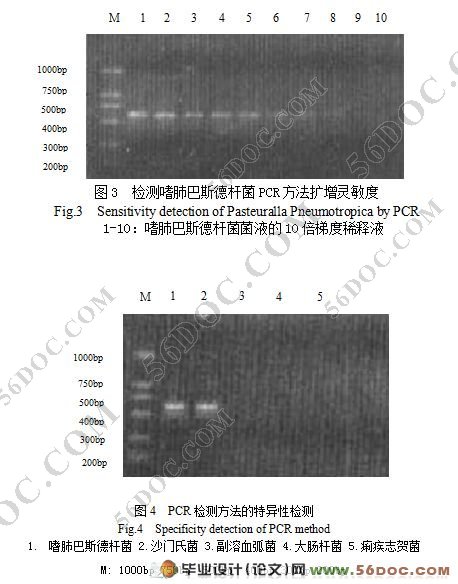嗜肺巴斯德杆菌16S rDNA-PCR检测方法的建立与应用
来源:56doc.com 资料编号:5D4399 资料等级:★★★★★ %E8%B5%84%E6%96%99%E7%BC%96%E5%8F%B7%EF%BC%9A5D4399
资料以网页介绍的为准,下载后不会有水印.资料仅供学习参考之用. 密 保 惠 帮助
资料介绍
摘 要: 根据细菌的16S rDNA-23S rDNA的高度保守区设计引物,扩增了嗜肺巴斯德杆菌的16S-23S rDNA间区,经测序获得521bp和683bp两条产物。用BLAST和DNAster软件对16S-23S rDNA间区序列进行比较分析,设计出对嗜肺巴斯德杆菌特异的PCR引物,进行了特异性、灵敏性检测分析。为建立检测嗜肺巴斯德杆菌的PCR方法奠定了良好的基础。
关健词: 嗜肺巴斯德杆菌;16S-23S rDNA间区;特异性;灵敏性
Establishment and application of Pasteurella pneumotropica coli 16S rDNA-PCR detection methods
Abstract: In this study, PCR primer Designed from 16S rDNA-23S rDNA conserved Intergenic Spacer Region and amplified this region, and obtained PCR products of 521bp and 683bp. These products sequenced. Using BLAST and DNAstar software to conduct comparison analysis to 16S-23S rDNA PCR products specific to Pasteurela pneumotropica, then PCR primers was conducted testing analysis of specificity and sensitivity. The purpose to make a good foundation to establish PCR-based method of detection to Pasteurela pneumotropica.
Key words: Pasteurela pneumotropica; 16S-23S rDNA Sequence; Specificity; Sensitivity

目 录 5200字
摘要……………………………………………………………………………………1
关键词…………………………………………………………………………1
1前言………………………………………………………………………………1
2 材料与方法…………………………………………………………………………2
2.1 材料………………………………………………………………………………2
2.1.1 主要菌株………………………………………………………………………2
2.1.2 主要试剂………………………………………………………………………2
2.2方法……………………………………………………………………3
2.2.1嗜肺巴斯德杆菌的培养………………………………………………………3
2.2.2模板DNA的制备………………………………………………………………3
2.2.3 16S - 23S rDNA间区的PCR扩增反应条件………………………………3
2.2.4 PCR产物的连接、转化及测序………………………………………………3
2.2.5 序列比较分析…………………………………………………………………3
2.2.6嗜肺巴斯德杆菌特异PCR引物的设计………………………………………3
2.2.7 PCR检测方法敏感性的检测…………………………………………………3
2.2.8 PCR检测方法特异性的检测…………………………………………………4
3 结果…………………………………………………………………………………4
3.1 PCR结果…………………………………………………………………………4
3.2 测序………………………………………………………………………………4
3.3 敏感性检测………………………………………………………………………5
3.4 PCR方法特异性的检测…………………………………………………………6
4 讨论…………………………………………………………………………………7
参考文献………………………………………………………………………………8
致谢……………………………………………………………………………………9
|



